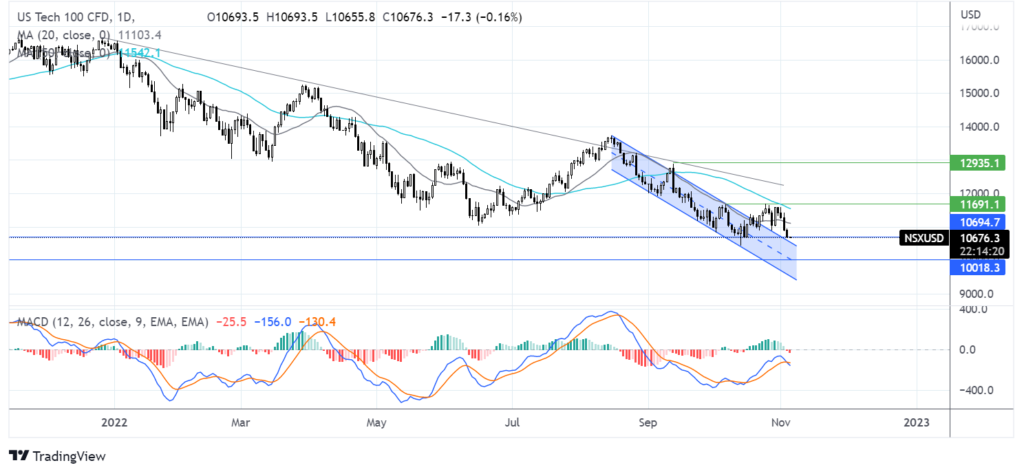US and Canadian jobs data in focus

Nasdaq looks to non-farm payrolls
The Nasdaq closed 1.7% lower yesterday, extending losses of 3.3% from Wednesday, and is set to lose over 6% so far this week. The US tech index fell after jobless claims were stronger than expected, and ISM service sector activity expanded strongly, supporting the Fed’s hawkish stance. Attention now turns to the US non-farm payroll, which could highlight the strength in the labor market. Expectations are that a little over 200k jobs were added in October, down from almost 300k in September; this would mark the lowest level in 10 months. Meanwhile, the unemployment rate is expected to tick higher to 3.6%, up from 3.5%, and wages grow at 0.3% MoM, in line with September. A strong jobs report would add evidence to support the Fed’s hawkish stance, potentially lifting the USD higher. A softer labor market report could pull the USD off recent highs.
Where might the Nasdaq price head to?
Nasdaq is rebounding lower from the 50 sma, breaking below the 20 sma and tests key support at 10670, the October 14 low, and the upper band of the multi-month falling channel. The bearish crossover on the MACD could hint toward further downside. Sellers need to break below 10670 to bring 10430, the 2022 low, into target. A break below here could create a lower low? On the upside, should buyers defend 10670, a move towards 11160, the 20 sma would be needed to expose the 50 sma at 11550? A move over 11685, last week’s high, could create a higher high.

GBP/USD recovers after post BoE fall
GBP/USD is rising today after falling almost 2% yesterday after the BoE raised interest rates by 75 basis points, as forecast. This was the largest rate hike from the central bank in over 3-decades as the BoE fights 4-decade high inflation. Interestingly the BoE said that the peak rate for inflation was likely to be lower than what the market is pricing in. Should rates follow the market curve, the UK could be looking at a two-year recession. However, with a lower peak inflation rate, a shorter shallower recession is likely. Still, lower growth and recession mean less aggressive rate hikes are required. This is in sharp contrast to the Fed, which warned that the peak rate would likely be higher than expected. The central bank divergence has pulled GBP/USD lower.
USD/CAD awaits Canadian jobs data
USD/CAD is declining on Friday ahead of jobs data from both Canada and the US. The pair is set to gain 1% across the week and has risen across the past six sessions as the USD benefits from a hawkish Fed Powell. Oil prices have offered little in the way of support to the loonie, trading flat across the week. Today Canadian jobs data could influence the loonie. Expectations are for unemployment to tick higher to 5.3%, up from 5.2%. Meanwhile, 10k additional jobs are expected to be added after 21k were added in August, highlighting tightness in the labor market even as inflation remains high and interest rates rise. Stronger than forecast jobs data could help to support the loonie. Meanwhile, weakness in the labour market could negatively impact CAD.
Support can be found at 1.36 (round number) and 1.35 (50 sma).
Resistance for the pair can be seen at 1.3710 (20 sma) and 1.38 (weekly high).
